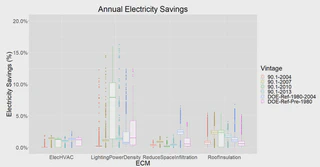Distribution of potential savings from urban-scale energy modeling of a utility
 Comparison of annual electricity savings for different vintages (color) and energy conservation measures.
Comparison of annual electricity savings for different vintages (color) and energy conservation measures.Abstract
While urban-scale building energy modeling is growing increasingly mature in data sources, algorithms, and empirical validation, there is still a need for best practices, guidelines, and standards for industryaccepted decision metrics relevant to specific use cases. Case studies are needed to inform such efforts. In addition, successful applications are need to motivate investment by, and in partnership with, utilities to scale grid-interactive efficient building technologies, realize aspirations of smart homes and cities, and dynamically dispatch load (rather than generation) in a way that stabilizes and reduces the cost of critical energy infrastructure. In partnership with the Electric Power Board of Chattanooga, TN, OpenStudio and EnergyPlus models were created of over 178,000 buildings and empirically validated against 15-minute whole-building electrical consumption of each building. Eight energy and demand-related measures relevant to nine utility-defined use cases are evaluated in over 2 million simulations of individual buildings to showcase statistical distributions over the entire building stock of potential savings for energy and demand.
Type
Publication
In Proceedings of Building Simulation 2021: 17th Conference of IBPSA